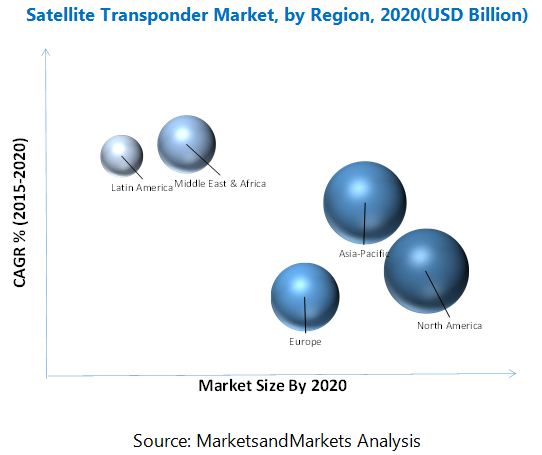Practices › Space › Satellite Transponder Market
Satellite Transponder Market
The satellite transponder market is expected to grow from USD 15.55 Billion in 2015 to USD 20.10 Billion by 2020, at a CAGR of 5.3% from 2015 to 2020. Satellite operators have shifted their focus towards supplying high capacity satellite transponders in terms of bandwidth that are capable of greater transponder throughput thereby reducing costs, in turn providing extra value to the customer.
Commercial communication applications are projected to dominate the global satellite transponder market over the forecast period. This high share of commercial communication applications in the overall market is driven by the development of new cost effective satellite technologies and increasing demand for telecommunication services across the globe. The majority of application of satellites are attributed to commercial communications. Commercial communication includes video distribution, DTH, legacy telephone and carrier services, commercial mobility services, OUTV, enterprise data service, broadband satellite access services, and others satellite based services which offer commercial use in air, maritime and land based communication.
In 2015, the C-band segment registered the largest market share, followed by the Ku-band and Ka-band segment in the satellite transponder bandwidth market. This large share is mainly attributed to the increasing usage of transponders of working on these bandwidths in weather forecasting, broadcasting, mapping, and many more applications. Moreover, C Band is the original frequency allocation for communications satellites. C-band satellite service is better suited for subscribers with large bandwidth requirements. This is because it easily supports enterprise level connectivity featuring dedicated CIR bandwidth with an SLA that guarantees uptime. This band is very dependable and less susceptible to weather related service outages. Also, the adoption of higher frequency bands typically give access to wider bandwidths, but are also more susceptible to signal degradation due to ‘rain fade’ (the absorption of radio signals by atmospheric rain, snow or ice).

The North American region holds the maximum market share in the satellite transponder market due to extensive necessity for secure and reliable satellite-based communication that is being used in video distribution, DTH, broadband accesses, and others, followed by Asia-Pacific. However, major growth will be witnessed in the Middle East & Africa and Latin America due to rise in demand for direct-to-home (DTH) satellite TV, high definition (HD) to replace standard definition (SD) offerings, need for secure communications for military and defense, and the vibrant broadcast industry in the region.
On the other hand, major restraints hampering the growth of the satellite transponder market include competition from fiber-optic transmission cable networks and requirement of huge capital investment.
Key market players such as Eutelsat Communications S.A., Intelsat S.A., and SES S.A. have adopted acquisition, as an eminent growth strategy to expand their client base and enter new markets with their improved solution capabilities.
To speak to our analyst for a discussion on the above findings, click Speak to Analyst
